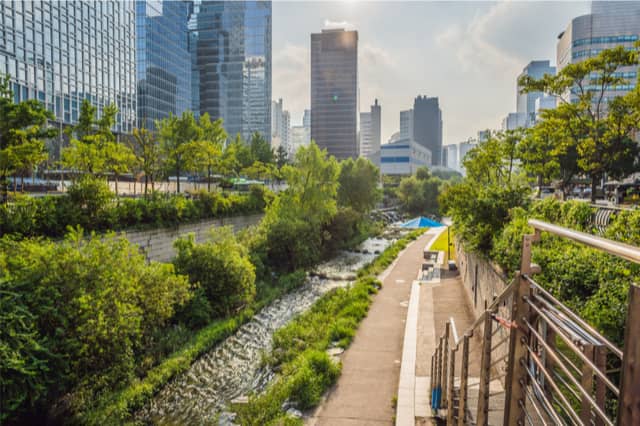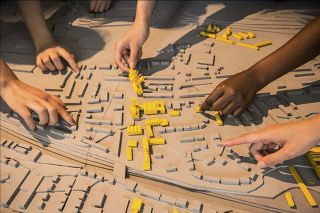
www.buildingsandcities.org/insights/commentaries/cop26-nature-based-solutions.html
COP-26: Make Nature-Based Solutions a Top Adaptation Priority

By Timon McPhearson (The New School, US)
Natural infrastructure is a critical urban infrastructure that provides fundamental and irreplaceable services for human health, wellbeing, and livelihoods. Urban development must quickly shift away from the dominant 20th century model that exacerbates hazards and risks by paving over urban ecological infrastructure. Firm commitments at COP-26 are needed to radically increase investments in nature-based solutions in cities: restoring, conserving and investing in green and blue infrastructure assets. This will reduce the impacts of climate change as part of an adaptation strategy and also improve wellbeing.
The current and future urban climate risks demonstrate a pressing need for putting the same level of global political will and economic investment in climate adaptation as there is in climate mitigation. Current levels of adaptation are not enough, despite leadership and increasing resilience and adaptation investments in both Global South and North cities. Global urban development must quickly shift away from the dominant 20th century model that largely paves over urban ecological infrastructure (Childers et al. 2019) creating urban heat islands, increasing flood risk, and placing low-income, minorities, and indigenous people on the front lines of climate disasters.
Cities concentrate people, infrastructure, and economic activity, creating vulnerabilities and risks to damaging impacts of climate change, extreme weather events, and other social and economic shocks. Weather and climate related extreme events are already increasing and thus rapid investments to shift current trajectories from vulnerable to resilient ones are paramount. Ambitious urban climate change adaptation and resilience building efforts in the built-up areas most at risk will mean the difference between moderate and severe social and economic consequences of near and longer-term climate change.
With $90 trillion expected to be invested in infrastructure in the coming years to support urbanization (IADB 2017), there is ample opportunity to transform urban development to both celebrate and harness nature for climate resilience. Though traditional hard engineered strategies will still be needed, we must harness the role of natural-based solutions to solve the climate crisis (Hobbie and Grimm 2020; Keeler et al. 2019; Frantzeskaki and McPhearson 2021).
Nature-based solutions (NbS) is an umbrella term including ecosystem-based adaptation, ecosystem-based disaster risk reduction, natural infrastructure, green and blue infrastructure, forest and landscape restoration, and natural climate solutions. Nature-based approaches are already being used in cities around the world to support climate change adaptation and resilience strategies because they provide multiple benefits including for flood protection, air and water quality regulation, and urban cooling while contributing to climate change mitigation and sustaining or enhancing biodiversity (McPhearson et al. 2015). Indeed, a large part of the appeal of NbS is their multifunctionality and potential to address multiple climate and urban wellbeing challenges simultaneously (Frantzeskaki et al. 2019; Chausson et al. 2020).
Climate resilient development pathways must have NbS at their center because the biodiversity crisis and climate crisis are fundamentally joined at the hip.We can't solve the climate crisis without nature, and we can't rebuild, restore, and reconnect to nature if we don't solve the climate crisis that is already wreaking havoc on our natural systems.Both crises are human caused and both require that we put nature-based solutions at the center of approaches to mitigate the multiple causes of biodiversity decline and accelerating climate change.
Though investments in NBS implementation have increased in recent years, the scale of investment needed is paltry compared to what is required to address the increasingly high stakes of climate impacts in cities. According to the World Economic Forum's Future of Nature and Business Report a nature-positive pathway in the infrastructure and built environment could create over $3 trillion in business opportunities and create 117 million jobs by 2030. The benefits are clear: NbS can stimulate economic activity, advance climate mitigation and adaptation, and support biodiversity protection. We can't ignore the powerful ally we have in urban nature any longer.
At COP-26 is it vital that nations make firm agreements to radically scale up investments in NbS in cities, and commit to restoring, conserving, and investing in green and blue infrastructure assets that inclusively address the stark inequalities of the poor, minority and indigenous populations who face the greatest burden of direct and indirect impacts of climate change. Though the rapid mobilization of funding to respond to the current pandemic with announcements of nearly USD$20 trillion in spending to stimulate economies and help them recover is promising, only a small fraction has to date been directed toward nature-based climate solutions (Rockstrom et al. 2021). NbS take time to mature. Trees must grow, green roofs need to be built, wetlands need conserving and restored. The time is now to rapidly and radically upscale NbS investments.
Investing in NbS implementation is key but we will need to invest in research to strengthen the evidence base for NbS since we still lack necessary information to assess the efficacy of different NbS in different urban contexts. This knowledge gap slows our ability to scale up and mainstream NbS for reducing urban heat, absorbing stormwater, protecting coastlines, and improving public health and mental health.
We must also co-create new governance mechanisms with local communities to make seats at the table for local communities to bring their expertise and goals to decision-making for NbS implementation. It is critical to ensure that investments to transform cities for adaptation and carbon neutrality do not reinforce the status quo of legacies of racism, displacement, disinvestment and lack of inclusion in decision-making that plague most of our cities (Spotswood et al. 2021). Improving livelihoods in cities is not just about decreasing our carbon footprint and shifting consumption patterns, it's also about reducing and redressing the disproportionate impacts that climate change and extreme weather events have on the poorest and most vulnerable.
Natural infrastructure is critical urban infrastructure that provides fundamental and irreplaceable services for human health, wellbeing, and livelihoods and therefore must be a top priority at COP26.
NbS are the solutions we need that can deliver on climate adaptation, support climate mitigation, and create space for biodiversity in cities at the same time.
References
Chausson, A., Turner, B., Seddon, D., Chabaneix, N., Girardin, C.A.J., Kapos, V., Key, I., Roe, D., Smith, A., Woroniecki, S. & Seddon, N. (2020). Mapping the effectiveness of nature-based solutions for climate change adaptation. Global Change Biology. doi: 10.1111/gcb.15310
Childers, D.L., Bois, P., Hartnett, H., McPhearson, T., Metson, G. & Sanchez, C.A. (2019). Urban ecological infrastructure: an inclusive concept for the non-built urban environment. Elementa: Science of the Anthropocene, 7(1): 46. doi: 10.1525/elementa.385
Frantzeskaki, N., & McPhearson, T. (2021). Mainstream nature-based solutions for urban climate resilience. BioScience, biab105. doi: 10.1093/biosci/biab105
Frantzeskaki, N., McPhearson, T., Collier, M., Kendal, D., Bulkeley, H., Dumitru, A., Walsh, C., Noble, K., van Wyk, E., Pinter, L., Ordonez, C., Oke, C., Elmqvist, T. (2019). Nature-based solutions for urban climate change adaptation: linking the science, policy and practice communities for evidence-based decision-making. Bioscience, 69, 455-566. doi: 10.1093/biosci/biz042
Hobbie, S.E. & Grimm, N.B. (2020). Nature-based approaches to managing climate change impacts in cities. Philosophical Transactions of the Royal Society B. doi: 10.1098/rstb.2019.0124
IADB. (2017). Crossing the bridge to sustainable infrastructure investing: exploring ways to make it across. Inter-American Development Bank. https://publications.iadb.org/en/crossing-bridge-sustainable-infrastructure-investing-exploring-ways-make-it-across
Keeler, B.L., Hamel, P., McPhearson, T., Hamann, M., Donahue, M., Meza Prado, K., Arkema, K., Bratman, G., Brauman, K., Finlay, J. , Guerry, A., Hobbie, S. , Johnson, J., MacDonald, G., McDonald, R., Neverisky, N. & Wood, S. (2019). Social-ecological and technological factors moderate the value of urban nature. Nature Sustainability, 2: 29-38.
McPhearson, T., Andersson, E., Elmqvist, T. & Frantzeskaki, N. (2015). Resilience of and through urban ecosystem services. Ecosystem Services, 12:152-156. doi: 10.1016/j.ecoser.2014.07.012
Rockström, J., Beringer, T., Hole, D., Griscom, B., Mascia, M.B., Folke, C. & Creutzig, F. (2021). We need biosphere stewardship that protects carbon sinks and builds resilience. PNAS 118 (38);e2115218118. doi: 10.1073/pnas.2115218118
Spotswood, E. N., Benjamin, M., Stoneburner, L., Wheeler, M.M., Beller, E.E., Balk, D., McPhearson, T., Kuo, M., & McDonald, R.I. (2021). Nature inequity and higher COVID-19 case rates in less-green neighbourhoods in the United States. Nature Sustainability, 1-7. doi: 10.1038/s41893-021-00781-9
Latest Peer-Reviewed Journal Content
Youth engagement in urban living labs: tools, methods and pedagogies
N Charalambous, C Panayi, C Mady, T Augustinčić & D Berc
Co-creating urban transformation: a stakeholder analysis for Germany’s heat transition
P Heger, C Bieber, M Hendawy & A Shooshtari
Placemaking living lab: creating resilient social and spatial infrastructures
M Dodd, N Madabhushi & R Lees
Church pipe organs: historical tuning records as indoor environmental evidence
B Bingley, A Knight & Y Xing
A framework for 1.5°C-aligned GHG budgets in architecture
G Betti, I Spaar, D Bachmann, A Jerosch-Herold, E Kühner, R Yang, K Avhad & S Sinning
Net zero retrofit of the building stock [editorial]
D Godoy-Shimizu & P Steadman
Co-learning in living labs: nurturing civic agency and resilience
A Belfield
The importance of multi-roles and code-switching in living labs
H Noller & A Tarik
Researchers’ shifting roles in living labs for knowledge co-production
C-C Dobre & G Faldi
Increasing civic resilience in urban living labs: city authorities’ roles
E Alatalo, M Laine & M Kyrönviita
Co-curation as civic practice in community engagement
Z Li, M Sunikka-Blank, R Purohit & F Samuel
Preserving buildings: emission reductions from circular economy strategies in Austria
N Alaux, V Kulmer, J Vogel & A Passer
Urban living labs: relationality between institutions and local circularity
P Palo, M Adelfio, J Lundin & E Brandão
Living labs: epistemic modelling, temporariness and land value
J Clossick, T Khonsari & U Steven
Co-creating interventions to prevent mosquito-borne disease transmission in hospitals
O Sloan Wood, E Lupenza, D M Agnello, J B Knudsen, M Msellem, K L Schiøler & F Saleh
Circularity at the neighbourhood scale: co-creative living lab lessons
J Honsa, A Versele, T Van de Kerckhove & C Piccardo
Positive energy districts and energy communities: how living labs create value
E Malakhatka, O Shafqat, A Sandoff & L Thuvander
Built environment governance and professionalism: the end of laissez-faire (again)
S Foxell
Co-creating justice in housing energy transitions through energy living labs
D Ricci, C Leiwakabessy, S van Wieringen, P de Koning & T Konstantinou
HVAC characterisation of existing Canadian buildings for decarbonisation retrofit identification
J Adebisi & J J McArthur
Simulation and the building performance gap [editorial]
M Donn
Developing criteria for effective building-sector commitments in nationally determined contributions
P Graham, K McFarlane & M Taheri
Join Our Community

The most important part of any journal is our people – readers, authors, reviewers, editorial board members and editors. You are cordially invited to join our community by joining our mailing list. We send out occasional emails about the journal – calls for papers, special issues, events and more.
We will not share your email with third parties. Read more



Latest Commentaries
COP30 Report
Matti Kuittinen (Aalto University) reflects on his experience of attending the 2025 UN Conference of the Parties in Belém, Brazil. The roadmaps and commitments failed to deliver the objectives of the 2025 Paris Agreement. However, 2 countries - Japan and Senegal - announced they are creating roadmaps to decarbonise their buildings. An international group of government ministers put housing on the agenda - specifying the need for reduced carbon and energy use along with affordability, quality and climate resilience.
Building-Related Research: New Context, New Challenges
Raymond J. Cole (University of British Columbia) reflects on the key challenges raised in the 34 commissioned essays for Buildings & Cities 5th anniversary. Not only are key research issues identified, but the consequences of changing contexts for conducting research and tailoring its influence on society are highlighted as key areas of action.